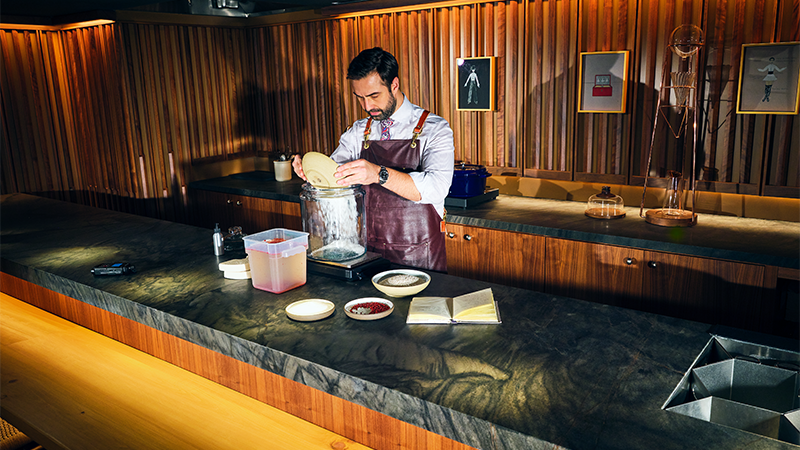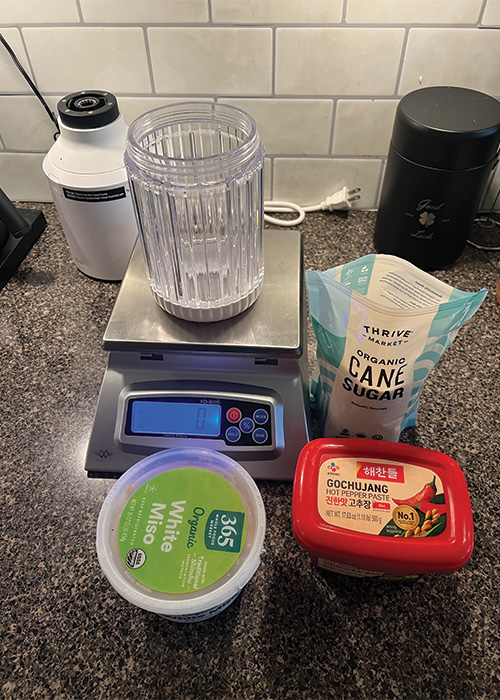I’m often asked by folks visiting New York, “What’s the best place to go get a cocktail?” Of course, there’s no one-size-fits-all answer here and I’ll need to know more about whether they’re looking for a cool vibe, great service, perfectly executed classics, more modern drinks, or a fantastic spirits list. I always try to tailor the recommendation to a spot that will deliver exactly what they’re looking for.
Or, if I’m really pressed for time, I can just tell them to go to the best kept secret in the New York bar scene and say: Eleven Madison Park.
EMP delivers it all. The restaurant’s cocktail menu is world class, whether you choose from one of their meticulously crafted originals that change with the season or a classic made with perfect ice and gorgeous glassware. The service lives up to its three-Michelin-star ranking, the room itself is iconic, and the back bar is chock-full of unicorn bottles. The kicker: While you can make a reservation for the bar, they even hold space for walk-ins.
It seems the bar team at EMP is tired of being a best-kept secret, because chef Daniel Humm and beverage director Sebastian Tollius have spent the last two years transforming what was once a private dining room and event space into Clemente Bar, a sleek, chic jewel box dedicated to advancing the cocktail.
The Studio at Clemente Bar offers a five-course cocktail and food pairing from an omakase-style counter with kitchen and bar staff working side by side, while The Lounge offers a more traditional drinking experience in a space that immerses guests in the art of the bar’s namesake, Francesco Clemente. The food and drinks mirror the plant-based ethos of Eleven Madison Park, but that limitation has only been a boon for the creativity of Sebastian and his team.

Amid the nonstop action of an opening, Sebastian took the time to chat with us about how fermentation — specifically the process of making miso — has transformed the way the team approaches the art of balancing drinks.
Taking Time to Develop
The seeds for the ideas that took root to become the menu at Clemente were planted in 2021 when Chef Humm removed all animal products from the menus at EMP. Suddenly, traditional sources of umami — meat, fish, and cheese — were no longer available. The team began to lean on the work of fermentation sous chef Brock Middleton to recreate those missing savory components from vegetable sources. This meant a wide variety of ferments including a robust miso program.
For Sebastian, these ingredients represented not only an opportunity for depth of flavor in his bar program, but also an unexpected source of opulence because of the weeks they took to develop flavor. “Time as an ingredient is something we had never considered,” he tells me. “Like, a 100-year-old soy sauce — that’s luxury.”

While many bars turn to fat-washing or expensive infusions to deliver elevated drinks to their guests, Sebastian found a way to create an experience that can’t be replicated by simply buying the highest-quality ingredients; these flavors have to be made with patience and care.
It all began when Sebastian built a cocktail featuring chef Brock’s barley miso for the menu at EMP. That ignited the curiosity of then head bartender and current Clemente bar manager Richie Millwater, who was so inspired by the ingredient that he started using it in all sorts of R and D projects. Sebastian encouraged him to branch out further and, with the help of chef Brock, create new ferments designed specifically for cocktails. Together, the trio have developed five distinct misos just for the cocktail menu at Clemente, including coconut, barley and plantain, pretzel, cacao and allspice, and pistachio and chicory.
“Air is the enemy here. Oxygen will disturb the fermentation and can actually cause a lot of off-flavors.”
Sebastian walks me through the process of making the coconut miso. It begins with a pink peppercorn tea — pink peppercorns blended with water and left to steep until the liquid is redolent with spice and floral notes. To a sterilized jar he adds the tea, powdered desiccated coconut, and koji, which is rice that’s been inoculated with aspergillus oryzae mold, the key ingredient that jumpstarts fermentation and develops delicious savory flavors.

Once the ingredients reach the proper consistency and hydration, Sebastian presses the paste into a firm puck to remove any pockets of trapped air. “Air is the enemy here,” he explains. “Oxygen will disturb the fermentation and can actually cause a lot of off-flavors.” After the sandy paste is pressed, he covers the surface with cheesecloth and adds weights to keep it firmly in place while it ferments.
Finally, he closes the jar, and moves it to a chamber held at 60 degrees Celsius for the next two weeks. Some of the other misos — barley in particular — can take as long as two months to reach the desired peanut-butter-like consistency and umami-rich flavor profile. Once the fermentation reaches where they want it, the team vacuum seals the miso in manageable units and freezes it to kill any further fermentation.
Miso in a Clemente Cocktail
Finished miso in hand, Sebastian is ready to make a drink. The coconut miso makes its way into the Sakura Heights, a vodka highball inspired by Taiwanese Cheese Tea — green or black iced tea topped with a sweet, savory cream cheese foam. He combines the coconut miso with Demerara syrup and lets it marinate for 24 hours before straining it through cloth to remove any large particles. At this point, the syrup has picked up all those delicious, fermented flavors, but the coconut and pink pepper remain at the forefront.
The miso syrup is married with vodka, Maraschino, fennel liqueur, cherry blossom vermouth, and Vin Santo del Chianti. The mixture is then coconut-milk-clarified with a combination of lemon and lactic acid. That lactic acid is key when using milk substitutes, Sebastian explains. It adds back the creaminess of a traditional dairy milk punch that’s missing from one made with a plant-based milk.

The finished mixture is force carbonated, poured into a highball glass with an immaculate ice spear, and topped with a foam made from vegan cream cheese, umeboshi (Japanese salted plum), citric acid, and salt. The final touch is a dusting of cherry blossom powder.
I get nervous when I hear so many ingredients and steps in the production of a drink. Surely some of those flavors will get lost in the shuffle? But every sip of the Sakura Heights arrives in perfect harmony — the richness of the cheese foam giving way to the subtle acidity and sweetness of the fortified wines with a rich, umami-driven mid-palate where the coconut and pink peppercorn shine. Sebastian explains that, while sugar and acid are the primary drivers of balance in drinks, adding a savory component takes the drinks at Clemente one step further, delivering a uniquely delicious and well-rounded experience for their guests. After finishing the Sakura Heights I’m inclined to agree. It’s one of the most delicious and sophisticated cocktails I’ve tasted this year.
Miso Drinks at Home
Frankly, it would be ridiculous to attempt to make miso at home, or anywhere outside of a facility set up specifically for that purpose. It’s completely unreasonable for anyone to have a fermentation chamber at home that’s held at 60 degrees Celsius for even 24 hours, much less up to two months! I would never fault someone for not doing something I would be unwilling to do myself, so no one is losing points for not going the whole nine yards and attempting long-term temperature-controlled ferments.

That said, I figured it was worth a shot to see if we could replicate some of the savory magic of Clemente’s cocktails at home with readily available grocery store ingredients. While Whole Foods 365 Brand white miso is certainly umami-rich, I definitely wouldn’t describe it as nuanced or especially interesting, so I decided to dial up the heat and combine it with gochujang and add both to a syrup.
The finished ingredient landed right in Spicy Sweet Chili Dorito territory in terms of sweet, savory heat. I combined the syrup with blanco tequila, Heirloom Pineapple Amaro, and lemon (along with some plain simple syrup to cut the intensity) into a sort of ultra-flavorful Daisy analogue. The result was… unremarkable. I gave it to my primary taster and fiancée Angel whose only notes after one sip was to make a face like I had deeply wronged her and exclaim, “OOF. Savory!” The drink isn’t bad, it just lacks the nuance and sophistication of the output of Clemente Bar. It makes me appreciate the work Sebastian and the team are doing even more. I’m including the recipe here as a sort of umami cocktails 101, so that if you try this, then eventually make your way to Clemente, you’ll appreciate just how remarkable their drinks are, too.
Spicy Sweet Daisy

Ingredients:
- 2 ounces blanco tequila
- ¾ ounce lemon juice
- ½ oounce Heirloom Pineapple Amaro
- ½ ounce simple syrup
- ¼ ounce Miso-Gochujang syrup
Method:
- Add all ingredients to a cocktail.
- Fill with ice and shake until chilled and diluted.
- Strain into a chilled coupe glass.
Miso-Gochujang Syrup

Ingredients:
- 100 grams water
- 100 grams sugar
- 50 grams white miso
- 50 grams gochujang
Method:
- Add all ingredients to a blender. Blend until emulsified.
This story is a part of VP Pro, our free platform and newsletter for drinks industry professionals, covering wine, beer, liquor, and beyond. Sign up for VP Pro now!
